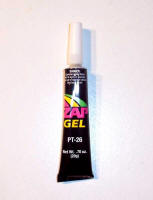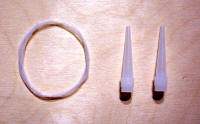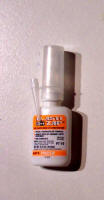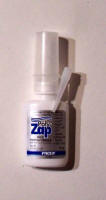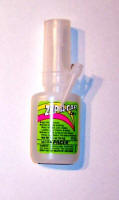| ZAP Cyanoacrylate Adhesives |
|
Reviewed By John Noack, #23017 |
|
Available at your local hobby shop and online via Frank Tiano
Enterprises (www.Franktiano.com);
prices vary by product line and size ordered. By way of background, many of you will be familiar with the "ZAP" family of cyanoacrylate adhesive products (aka super glue). CA has become the modeler's choice for many bonding processes, and a complete family of CA-based products has sprung up, not only for bonding styrene to itself, but for attaching resin or photoetch, gap filling, and adding the occasional index finger semi-permanently to a project (go ahead and ask how I know this). One product line well known to RC modelers, and steadily making inroads in the scale modeling hobby, is Pacer Technology's ZAP adhesives. I contacted Frank Tiano (FTE Enterprises, the regional distributor for ZAP) in the hopes that his company would support our Make and Take project with a donation; not only did Frank send a large quantity of supplies to Steve Dottavio, our MnT Coordinator, he also provided a range of products of interest to the scale modeler. So, with that as background, here we go with an introduction to the world of ZAP CA products: |
| First up is ZAP Gel, which comes in a 3 gram or 20 gram (shown here) tube. This is the thickest of the ZAP CA products and, as you might expect, works well as a gap filler. I used this product on an old Williams Brothers kit I've been plugging away at for some time and successfully filled several seams that ranged up to 1/16" (0.060) wide - I suspect I could have gone further, but fortunately, didn't have to! The one thing to remember about all CA products is that the hardness - and therefore, the amount of effort required to sand - goes up over time. I'd suggest you wet sand the filled seam within an hour or two or you'd best plan on getting out the industrial grinder. All kidding aside, do some gluing and some sanding if this is an ongoing project. I like to wet sand the joint, let it dry in my drying booth, apply a coat of quick drying gloss acrylic paint over the seam, and look for areas I need to re-do. Your mileage may vary. |
| Next up - ZAP CA. This is the other range of the scale from ZAP Gel; CA is the lowest viscosity of the products noted here. In fact, it has the consistency of water. Best uses? Joining two parts that have minimal gaps - a good example might be the upper and lower wing assembly. The good news is that capillary action will draw CA through the bondline; you can actually see the adhesive "wick" it's way along the joint. The bad news? Be careful - this stuff can run everywhere, including under your fingers. Your first indication that you've become part of the model is usually the sensation that your fingers are on fire; CA will often release a lot of heat during the curing process. My solution is to tack the joint first, maybe with one of the thicker grades of CA; let this set up and then use the thin product to fill the remainder of the seam.. Wearing disposable gloves isn't a bad idea. Also, be careful if you tape the pieces together first - CA will merrily run under the tape and make it a permanent part of the project. All the ZAP products other than Gel come with an applicator that's attached to the cap - use them! I've also included some photos of spare applicators and Teflon tubing that ZAP supplies - these are great for directing the flow of the adhesive and minimizing overspills. As an aside, this product is well-loved by RC and wooden ship modelers as it makes a wood joint that's far stronger than the balsa parent material. |
| Next up is Plasti-ZAP, a medium viscosity formula that's intended for various types of plastic. If you're going to go with one type of CA, this is probably the best choice for the scale modeler. It's less "aggressive" than some of the other formulations and is advertised as not attacking paint. I didn't risk proving or disproving this theory, but again, for most common tasks, it's a good compromise between the gel and super-thin products. By the way, if you're trying to re-attach loose trim molding on your auto, this is the stuff to use (voice of experience….). |
| Poly-ZAP is formulated for various engineered plastics (Lexan, Delron, Nylon) as well as rubber-based materials. While its uses are limited for us plastic modelers, it is advertised to not fog canopies if an accelerator ('kicker") is not used. I generally attach clear parts with white glue, but have subsequently lost them while wet-sanding or masking. I haven't tried Poly-ZAP for this purpose yet but I plan to. |
| Last up is ZAP-A-GAP, possibly the best known Pacer product for static scale modelers. Z-A-G is a medium viscosity adhesive, about the viscosity of maple syrup, intended as a gap filler. I'd use Zap-A-Gap to join mismatched parts where you can't (or don't want to) sand the two surfaces for a tight joint. Of course, its' other role is as a gap filler and most modelers who use CA as a surface filler will use Z-A-G to fill pinholes, popped seams, and those ever-present-ejector pin spots. Zap-A-Gap in concert with a good accelerator (and yes, Zap Kicker is available in pump or spray versions) can turn several days of filling, drying and sanding into an hour's worth of work. Again, don't let this stuff age - unlike a fine wine, your pleasure won't increase over time! |
| I'd like to thank Frank Tiano again for supplying the review samples noted here as well as for his support to Make and Take. Next up I'll review some of the sanding disk products also available from FTE. |
|
Information, images, and all other items placed electronically on this site are the intellectual property of IPMS/USA ®. |
